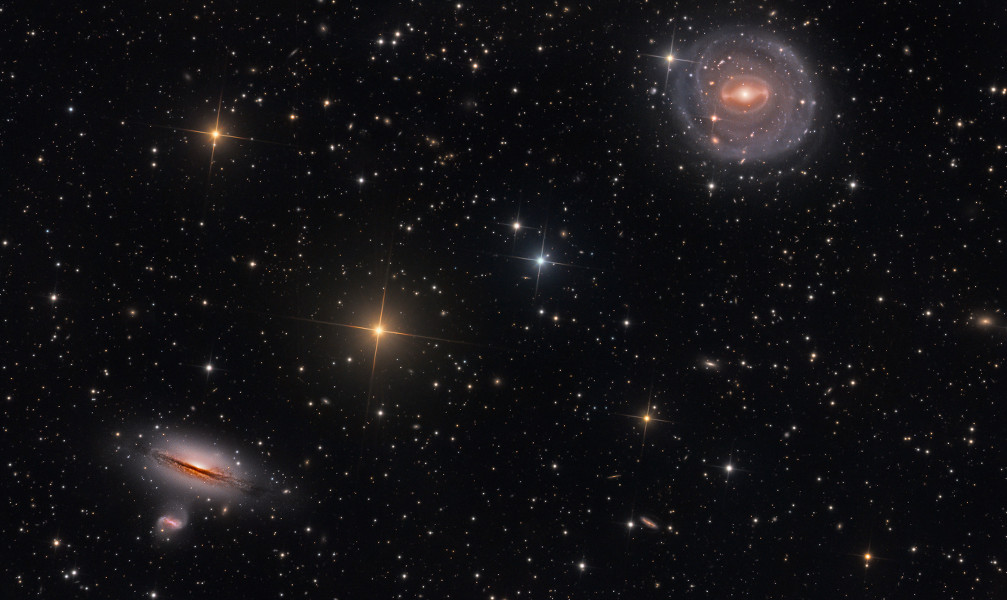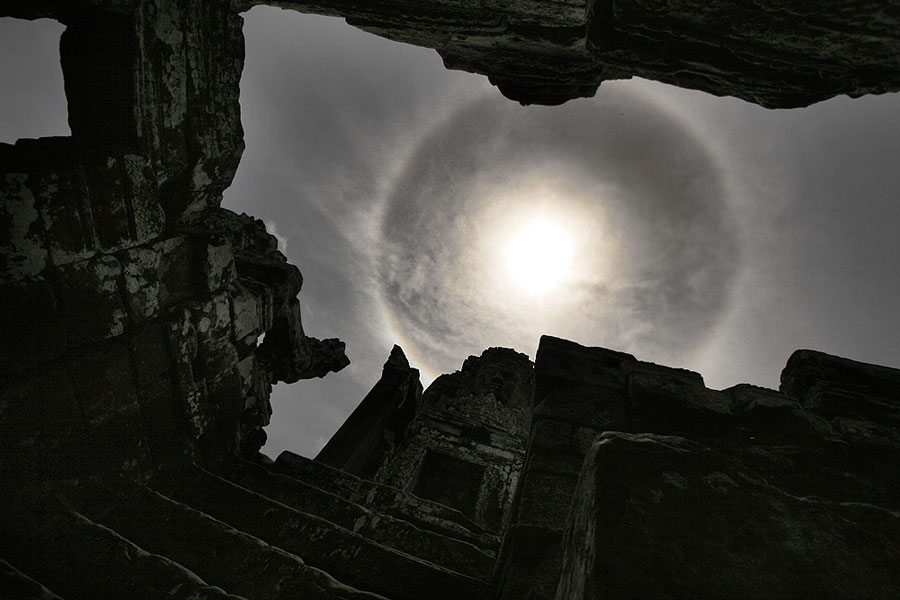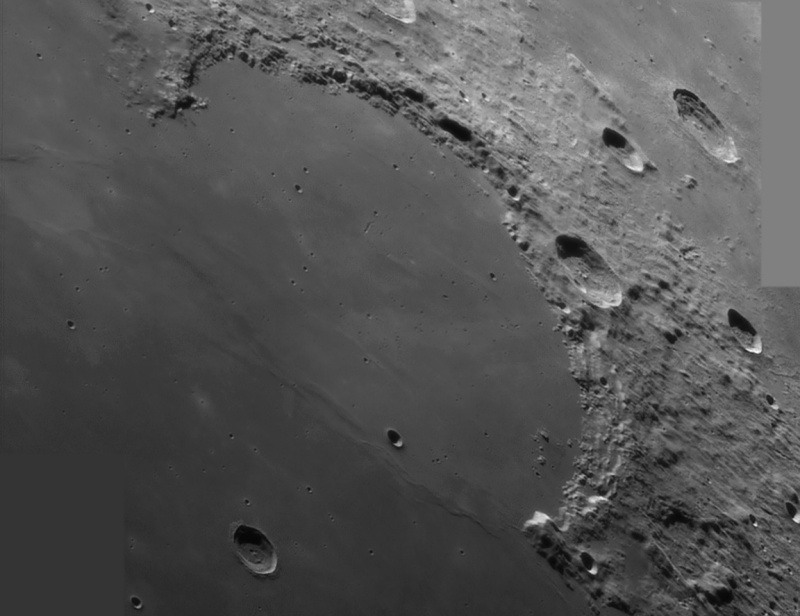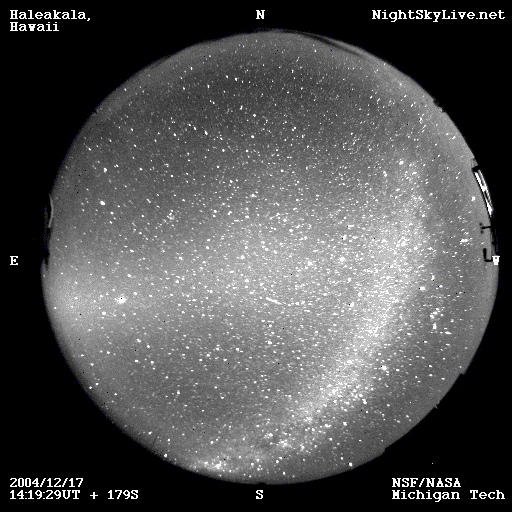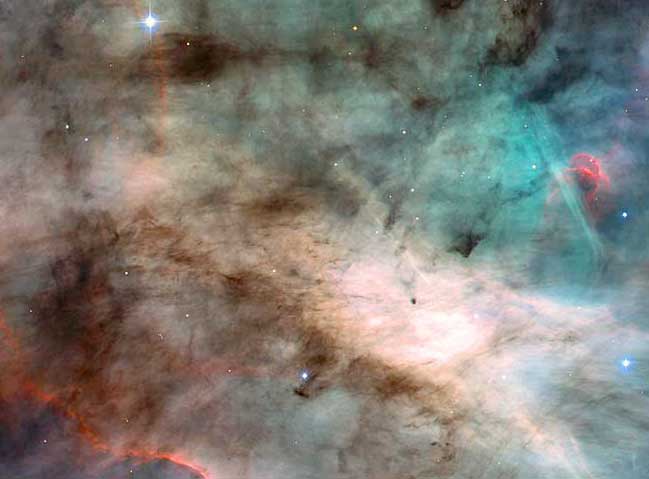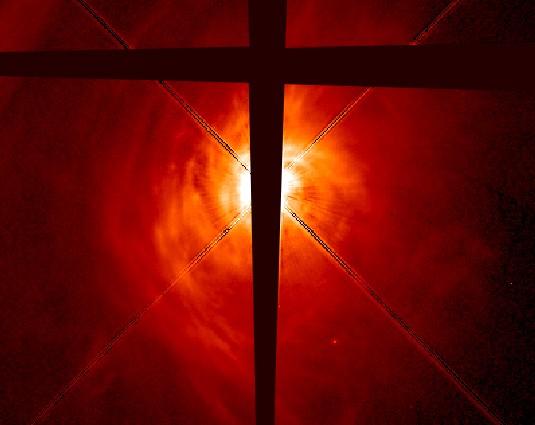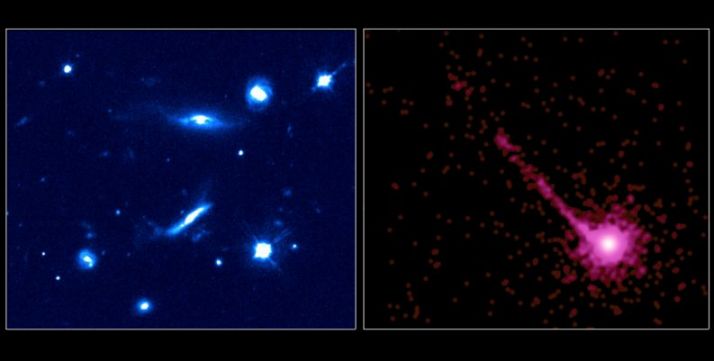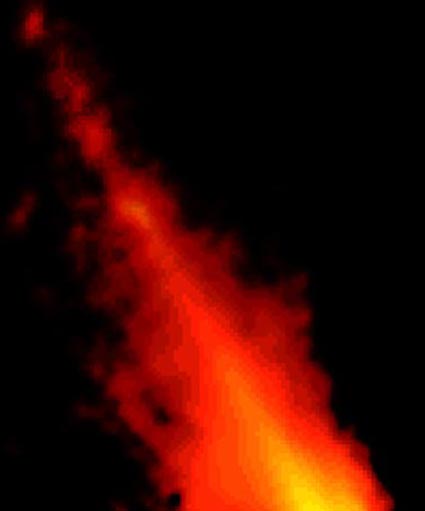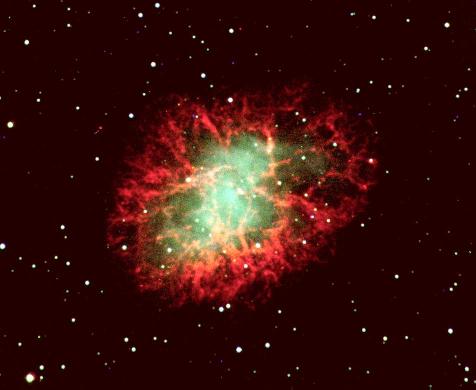| << Previous | Index | Next >> |
2015 This cosmic pillar of gas and dust is nearly two light-years wide. The structure lies within one of our galaxy's largest star forming regions, the Carina Nebula, shining in southern skies at a distance of about 7,500 light-years. The pillar's convoluted outlines are shaped by the winds and radiation of Carina's young, hot, massive stars. But the interior of the cosmic pillar itself is home to stars in the process of formation. In fact, a penetrating infrared view shows the pillar is dominated by two, narrow, energetic jets blasting outward from a still hidden infant star. The above featured visible light image was made in 2009 using the Hubble Space Telescope's Wide Field Camera 3.
2014 This sharp telescopic field of view holds two bright galaxies. Barred spiral NGC 5101 (top right) and nearly edge-on system NGC 5078 are separated on the sky by about 0.5 degrees or about the apparent width of a full moon. Found within the boundaries of the serpentine constellation Hydra, both are estimated to be around 90 million light-years away and similar in size to our own large Milky Way galaxy. In fact, if they both lie at the same distance their projected separation would be only 800,000 light-years or so. That's easily less than half the distance between the Milky Way and the Andromeda Galaxy. NGC 5078 is interacting with a smaller companion galaxy, cataloged as IC 879, seen just below and left of the larger galaxy's bright core. Even more distant background galaxies are scattered around the colorful field. Some are even visible right through the face-on disk of NGC 5101. But the prominent spiky stars are in the foreground, well within our own Milky Way.
2013 Grand spiral galaxies often seem to get all the glory, flaunting their young, bright, blue star clusters in beautiful, symmetric spiral arms. But small galaxies form stars too, like nearby NGC 6822, also known as Barnard's Galaxy. Beyond the rich starfields in the constellation Sagittarius, NGC 6822 is a mere 1.5 million light-years away, a member of our Local Group of galaxies. About 7,000 light-years across, the dwarf irregular galaxy is seen to be filled with young blue stars and mottled with the telltale pinkish hydrogen glow of star forming regions in the deep color composite image. Contributing to the science of LITTLE THINGS, this portrait of a small galaxy was made as part of the Lowell Amateur Research Initiative (LARI), welcoming collaborations with amateur astronomers.
2012 This moon is shining by the light of its planet. Specifically, a large portion of Enceladus pictured above is illuminated primarily by sunlight first reflected from the planet Saturn. The result is that the normally snow-white moon appears in the gold color of Saturn's cloud tops. As most of the illumination comes from the image left, a labyrinth of ridges throws notable shadows just to the right of the image center, while the kilometer-deep canyon Labtayt Sulci is visible just below. The bright thin crescent on the far right is the only part of Enceladus directly lit by the Sun. The above image was taken last year by the robotic Cassini spacecraft during a close pass by by the enigmatic moon. Inspection of the lower part of this digitally sharpened image reveals plumes of ice crystals thought to originate in a below-surface sea.
2011 Why would a cloud appear to be different colors? A relatively rare phenomenon known as iridescent clouds can show unusual colors vividly or a whole spectrum of colors simultaneously. These clouds are formed of small water droplets of nearly uniform size. When the Sun is in the right position and mostly hidden by thick clouds, these thinner clouds significantly diffract sunlight in a nearly coherent manner, with different colors being deflected by different amounts. Therefore, different colors will come to the observer from slightly different directions. Many clouds start with uniform regions that could show iridescence but quickly become too thick, too mixed, or too far from the Sun to exhibit striking colors. This iridescent cloud was photographed last year from the Top of the World Highway outside Dawson City, in the Yukon Territory in Northern Canada.
2010 Have you ever seen a halo around the Sun? This fairly common sight occurs when high thin clouds containing millions of tiny ice crystals cover much of the sky. Each ice crystal acts like a miniature lens. Because most of the crystals have a similar elongated hexagonal shape, light entering one crystal face and exiting through the opposing face refracts 22 degrees, which corresponds to the radius of the Sun halo. A similar Moon halo may be visible during the night. Pictured above, a nearly complete sun halo was photographed high above the ancient Bayon temple in Angkor, Cambodia. Exactly how ice-crystals form in clouds remains under investigation.
2009 From afar, the whole thing looks like an Eagle. A closer look at the Eagle Nebula, however, shows the bright region is actually a window into the center of a larger dark shell of dust. Through this window, a brightly-lit workshop appears where a whole open cluster of stars is being formed. In this cavity tall pillars and round globules of dark dust and cold molecular gas remain where stars are still forming. Already visible are several young bright blue stars whose light and winds are burning away and pushing back the remaining filaments and walls of gas and dust. The Eagle emission nebula, tagged M16, lies about 6500 light years away, spans about 20 light-years, and is visible with binoculars toward the constellation of the Serpent (Serpens). This picture combines three specific emitted colors and was taken with the 0.9-meter telescope on Kitt Peak, Arizona, USA.
2008 Dark, smooth regions that cover the Moon's familiar face are called by Latin names for oceans and seas. The naming convention is historical, though it may seem a little ironic to denizens of the space age who recognize the Moon as a mostly dry and airless world, and the smooth, dark areas as lava-flooded impact basins. For example, this elegant lunar vista, a careful mosaic of telescopic images, looks across the expanse of the northwestern Mare Imbrium, or Sea of Rains, into the Sinus Iridum - the Bay of Rainbows. Ringed by the Jura Mountains (montes), the bay is about 250 kilometers across, bounded at the bottom of the rugged arc by Cape (promontorium) Laplace. The cape's sunlit face towers nearly 3,000 meters above the bay's surface. At the top of the arc is Cape Heraclides, at times seen as a moon maiden.
2007
2006 Some moons wouldn't survive the collision. Tethys, one of Saturn's larger moons at about 1000 kilometers in diameter, survived the collision, but sports today the expansive impact crater Odysseus. Sometimes called the Great Basin, Odysseus occurs on the leading hemisphere of Tethys and shows its great age by the relative amount of smaller craters that occur inside its towering walls. The density of Tethys is similar to water-ice. The above digitally enhanced image was captured late last year by the robot Cassini spacecraft in orbit around Saturn as it swooped past the giant ice ball.
2005 What in heavens-above was that? Not everything seen on the night sky is understood. The Night Sky Live (NSL) project keeps its global array of continuously updating web cameras (CONCAMs) always watching the night sky. On the night of 2004 December 17, the fisheye CONCAM perched on top of an active volcano in Haleakala, Hawaii, saw something moving across the night sky that remains mysterious. The NSL team might have disregarded the above streak as unconfirmed, but the Mauna Kea CONCAM on the next Hawaiian island recorded the same thing. The NSL team might then have disregarded the streak as a satellite, but no record of it was found in the heavens-above.com site that usually documents bright satellite events. If you think you have a reasonable explanation for the streak, please contribute to the on-line discussion. Current candidates include a known satellite that was somehow missed by heavens-above, a recently launched rocket, and a passing space rock. Volunteers are solicited by the NSL project to help monitor the operability of each NSL CONCAM, including looking for interesting anomalies such as this. Disclosure: Robert Nemiroff collaborates on both the NSL and APOD projects.
2004 In the depths of the dark clouds of dust and molecular gas known as the Omega Nebula, stars continue to form. The above image from the Hubble Space Telescope's Advanced Camera for Surveys shows exquisite detail in the famous star-forming region. The dark dust filaments that lace the center of Omega Nebula were created in the atmospheres of cool giant stars and in the debris from supernova explosions. The red and blue hues arise from glowing gas heated by the radiation of massive nearby stars. The points of light are the young stars themselves, some brighter than 100 Suns. Dark globules mark even younger systems, clouds of gas and dust just now condensing to form stars and planets. The Omega Nebula lies about 5000 light years away toward the constellation of Sagittarius. The region shown spans about 3000 times the diameter of our Solar System.
2003 This enhanced Hubble Space Telescope image shows in remarkable detail the inner portion of the disk of dust and gas surrounding the star AB Aurigae. Knots of material, visible here for the first time, may well represent an early stage of a process which could result in the formation of planets over the next few million years. AB Aurigae is a young star (2-4 million years old), about 469 light-years distant. Its swirling circumstellar disk is large, about 30 times the size of our solar system. Astronomers believe planet-making is just beginning in AB Aurigae's disk because known disks surrounding younger stars (less than 1 million years old) do not show such clumpy structure, while disks of slightly older stars (aged 8-10 million years) have gaps and features suggesting that planets have already been formed. Why the window pane appearance? Wide black stripes in the picture are caused by occulting bars used to block out the overwhelming starlight. The diagonal streaks are due to diffraction spikes.
2002 The quasar known as PKS 1127-145 lies ten billion light-years from our fair planet. A Hubble Space Telescope view in the left panel shows this quasar along with other galaxies as they appear in optical light. The quasar itself is the brightest object in the lower right corner. In the right panel is a Chandra Observatory x-ray picture, exactly corresponding to the Hubble field. While the more ordinary galaxies are not seen in the Chandra image, a striking jet, nearly a million light-years long, emerges from the quasar to dominate the x-ray view. Bright in both optical and x-ray light, the quasar is thought to harbor a supermassive black hole which powers the jet and makes PKS 1127-145 visible across the spectrum -- a beacon from the distant cosmos.
2001 Radio waves, like visible light, are electromagnetic radiation and radio telescopes can "see" -- their signals translate into radio images of the cosmos. While individually even the largest radio telescopes have very blurry vision compared to their optical counterparts, networks of radio telescopes can combine signals to produce sharper pictures. In fact, using an NRAO supercomputer in New Mexico, USA and technique called VLBI (Very Long Baseline Interferometry), the European network of radio telescopes (EVN) has produced pictures of distant galaxies at a resolution some three times higher than the Hubble Space Telescope. Penetrating obscuring dust, the false-color EVN radio images are inset above according to their relative location in an optical image of the famous Hubble Deep Field region of the sky. (Yellow lines superimposed on the optical image are radio intensity contours from a single telescope.) The bright cosmic radio source in the middle of each inset corresponds to a galaxy. Impressively, the radio sources appear to be so small, less than about 600 light-years across in actual size, that they are thought to be associated with massive central black holes in the distant deep field galaxies.
2000 An unusual dust disk surrounds nearby star Beta Pictoris. Discovered in 1983, astronomers are still learning just how unusual this disk is. Recent images and computer simulations indicate that the disk contains several elliptical dust rings larger than our own Solar System. The above image taken with the Hubble Space Telescope uncovered evidence of these rings as apparent knots in the edge-on disk. The ring model naturally explains why the disk protrudes longer on one side than the other. These rings might have been formed when a nearby star passed Beta Pic about 100,000 years ago. Astronomers are searching for this intruder star, which is not the foreground star visible in the wider image. Beta Pic is only 50 light-years away and thought to harbor planets.
1999 Winds of fast particles blow out from the Sun, but why? Astronomers came a step closer to answering this question recently by making detailed observations of the high-speed wind source with the space-borne Solar and Heliospheric Observatory (SOHO). Images like those shown above isolate regions of inflowing gas, shown in red, and outflowing gas, shown in blue. Particles such as electrons and protons flow out at speeds near 3 million kilometers per hour. This wind will typically enter one of the Sun's coronal holes before flowing out into the Solar System. Analysis indicates that the high-speed wind escapes at the edges of large convection cells, drawn in black. SOHO has recently been revived to run without the use of any orienting gyroscopes.
1998 The Crab Nebula, filled with mysterious filaments, is the result of a star that exploded in 1054 AD. This spectacular supernova explosion was recorded by Chinese and (quite probably) Anasazi Indian astronomers. The filaments are mysterious because they appear to have less mass than expelled in the original supernova and higher speed than expected from a free explosion. In the above picture, the color indicates what is happening to the electrons in different parts of the Crab Nebula. Red indicates the electrons are recombining with protons to form neutral hydrogen, while green indicates the electrons are whirling around the magnetic field of the inner nebula. In the nebula's very center lies a pulsar: a neutron star rotating, in this case, 30 times a second.
1997 The famous Sombrero galaxy (M104) is a bright nearby spiral galaxy. The prominent dust lane and halo of stars and globular clusters give this galaxy its name. Something very energetic is going on in the Sombrero's center, as much X-ray light has been detected from it. This X-ray emission coupled with unusually high central stellar velocities cause many astronomers to speculate that a black hole lies at the Sombrero's center - a black hole a billion times the mass of our Sun.
1996 Get ready for one of the most impressive but least anticipated light shows in modern astronomical history. Next month, newly discovered Comet Hyakutake will pass closer to the Earth than any recent comet. Unknown before its discovery by Yuji Hyakutake on 30 January 1996, the fuzzy spot in the above photograph is a comet now predicted to become bright enough to see without a telescope. Although comets act in such diverse ways that predictions are frequently inaccurate, even conservative estimates indicate that this comet is likely to impress. For example, even if Comet Hyakutake remains physically unchanged, its close pass near the Earth in late March 1996 should cause it to appear to brighten to about 3rd magnitude - still bright enough to see with the unaided eye. In the next two months, though, the comet will continue to approach the Sun and hence should become brighter still. Optimistic predictions include that Comet Hyakutake will change physically, develop a larger coma and tail, brighten dramatically, move noticeably in the sky during a single night, and may ultimately become known as the "The Great Comet of 1996." Move over Hale-Bopp!
| << Previous | Index | Next >> |

